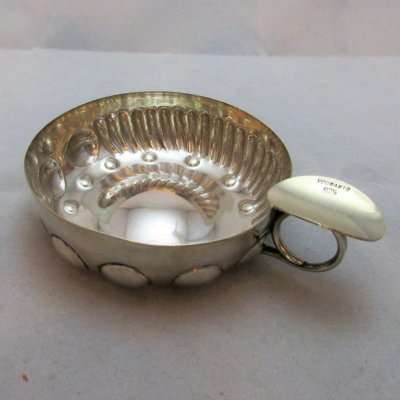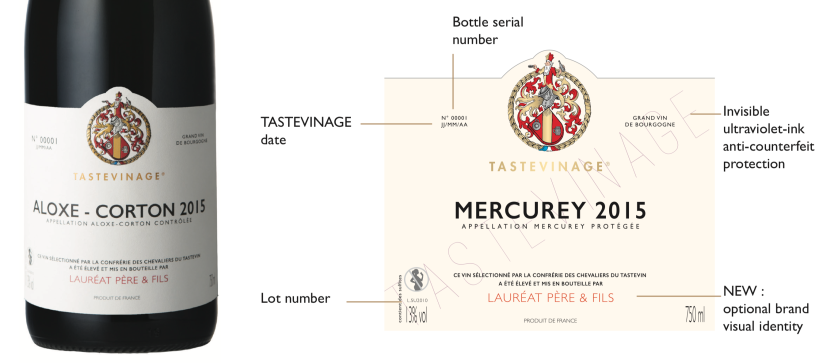What is a tastevin cup and why do sommeliers wear it around their neck?
What do you buy the wine lover that has every wine glass imaginable? A Tastevin cup, that’s what. And not just any tastevin cup, a French antique tastevin cup.
Okay, now that we have a name, what exactly is a Tastevin cup?

Tastevin History
Dating back as far as the 15th century, a tastevin (pronounced “taht-vahn”, and translating to “taste wine”), is a small, shallow wine tasting cup (usually silver), that was used by winemakers to evaluate the color and clarity of a wine.
Centuries ago, all of this evaluating was done in a dark, candlelit cellar, so the tastevin was designed with indentations in its sides that catch and reflect light, making it possible to see through the wine to check clarity.
It also kind of looks like an ash tray. Not an ash tray.
Clarity isn’t much of an issue with modern winemaking (at least not with good winemaking), and we’ve got electricity now, so the tastevin has mostly been relegated to novelty/collector status.
Tastevin design varies with the type of wine to be evaluated. A tastevin with small linear grooves (gordons) is designed for evaluating white wines. A tastevin with round indentations (cupules) is for red wines. Sometimes the two forms were combined in a single tastevin.


Older tastevins (like mine) often feature a coin embedded in the bottom of the cup — the coin in my tastevin is a 5 Franc coin from 1868, featuring Emperor Napoleon III.
It seems to be decoration and/or repair. The coin is absolutely not to be used as a way to date a tastevin.
You can, however, date your tastevin by its silver hallmarks. My tastevin cup dates to the second half of the 19th century.
The Symbol Of Dionysus- The God Of Wine
Another traditional feature of the tastevin is a handle in the shape of intertwined snakes — a nod to Dionysus/Bacchus, the God of Wine.
Dionysus was the son of Zeus and a mortal woman named Semele. As you can imagine, Zeus’ wife, Hera, wasn’t exactly pleased when she found out Semele was pregnant.
So she tricked Semele into demanding that Zeus reveal his true form (lightning bolts and such) to her.
Mortals can’t look at a god’s true form without being incinerated on the spot — so long, Semele. In the chaos of all the incinerating, Zeus managed to rescue his unborn son, and sewed him into his thigh.
And, a few months later, Dionysus emerged from Zeus’ thigh, and Zeus gave him a crown of snakes (worst birthday gift ever).

Years later, once people started worshipping Dionysus (at Cult of Dionysys parties), they would wind snakes around their arms, convinced they could “charm” them.
I’m not saying this sounds a lot like what goes on at certain churches in Appalachia. But this sounds a lot like what goes on at certain churches in Appalachia.
Speaking of Bacchanalia . . .
There is an exclusive (slightly secretive) fraternity in Burgundy called the Confrérie des Chevaliers du Tastevin.
First founded as the Ordre de la Boisson (Order of the Beverage) in 1703, the modern version was created in 1934.
Their mission is to promote Burgundian wines and culture. There are somewhere around 12,000 knights, or chevaliers, in the order.
And they have the snazziest costumes.

Twice a year, they get together at the Confrérie’s headquarters, the Château du Clos de Vougeot, to judge the new vintage of Burgundy wines.
Top wines are awarded the title, “Tastevinage” carry a special label.

Honestly, they remind me of the “you can’t sit with us” table in high school. They are admittedly a private club, with no desire for a noticeable increase of membership.
If you want to join, you must be presented and sponsored by two members. Just remember, (and this is directly from their website) — the Tastevin does not just receive “anyone” no matter how successful he or she may be.
Oh well. Red isn’t my color, anyway.
Tastevin Cup FAQ
What is a Tastevin cup?
Dating back as far as the 15th century, a tastevin (pronounced “taht-vahn”, and translating to “taste wine”), is a small, shallow cup (usually silver), that was used by winemakers to evaluate the color and clarity of a wine.
What is a sommelier cup called?
It’s called a tastevin (pronounced “taht-vahn”, and translating to “taste wine”), is a small, shallow wine tasting cup (usually silver), that was used by winemakers to evaluate the color and clarity of a wine. Centuries ago, all of this evaluating was done in a dark, candlelit cellar, so the tastevin was designed with indentations in its sides that catch and reflect light, making it possible to see through the wine to check clarity. It also kind of looks like an ash tray.
What does a sommelier use to taste wine?
A tastevin (pronounced “taht-vahn”, and translating to “taste wine”) was not originally designed for sommeliers. It was originally designed for winemakers tasting in candle-lit cellars. The shape of a shiny tastevin would reflect whatever light was there, making it easier to judge the color and clarity of a wine.
How do you pronounce tastevin?
Tastevin is pronounced “taht-vahn”, and translating to “taste wine”.
Why does a sommelier wear around his neck?
That’s called a “tastevin” (which is French for “taste wine” and pronounced “taht-vahn” ). This shallow silver metal cup is faceted and convex so that when you’re in a candle-lit cellar (before electricity), you can judge the color and clarity of a wine.









